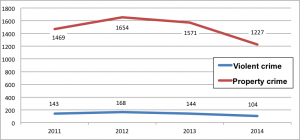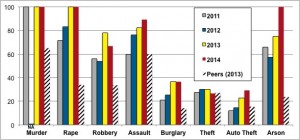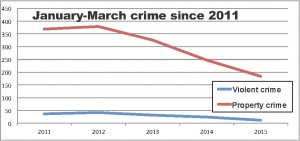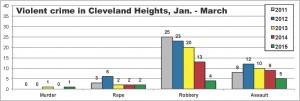Here is a series of charts using crime data from the Cleveland Heights Police Department. All of these have been published previously in the Heights Observer. I’m providing them as a quick visual to see crime trends. For information on how the data are gathered and managed, read the original article in the Heights Observer series, Understanding Crime in Cleveland Heights, which went online Jan. 3, 2015.
Overall crime trend
This first chart shows the downward trend in overall crime since 2011. The red line is property crime and the blue line is violent crime. The data represents the

full 12 months of each year, and shows a significant delcline in both categories. The numbers don’t reflect every call that comes into the police department, nor do they include minor crimes like trespassing, disturbing the peace or driving under the influence. The FBI – which provides the recommended methodology for collecting police data – deems such “Part II” crimes as too numerous for police departments to track with such detail.

Rather, these charts represent “Part I” crimes – serious crimes that are defined by correlating FBI guidelines with criminal codes that vary state by state. Just the process of defining crimes can be complicated and time-consuming. The beginning date for this crime data is 2011 because that’s when the CHPD implemented a new process to collect, categorize and report crime data. The goal of this process, according to Police Chief Jeffrey Robertson is consistency and accuracy, allowing effective management of department resources.

The second chart provides full-year comparisons of violent crimes since 2011, broken down by category. The total number of crimes in each year on this chart corresponds with the blue line in the chart above.
The third chart shows the full year’s worth of property crimes in each year since 2011, again broken down by category. The total for each year on this chart corresponds with the red line above.
Clearing crimes off the books
The same FBI methodology for reporting crime also covers “crime clearance rates” – how effectively police departments get crimes off the books. To qualify as

“cleared,” a crime must be solved with one or more people arrested, charged and delivered for prosecution. In certain instances when a suspect has been identified but cannot be arrested (for example, the suspect has died), the crime is also considered cleared. While lower numbers are better in the previous charts, a higher crime clearance rate is better. A clearance rate of 90% means nine out of 10 crimes in a given category have been solved and turned over for prosecution. Each shaded bar represents the CHPD’s clearance rate in a specific crime category for a specific year. The striped bar is the average clearance rate of “peer agencies” – police departments in cities wth a population of 25,000-49,999. (The 2013 population of Cleveland Heights, according to the U.S. Census, is 45,394.) The peer comparison is provided by the FBI.
How 2015 looks so far
The next three charts are crime data reported in the same format as the year-end data above, but represent data only from January through March – the first three months of each year. The first quarter of the year tends to be the quietest part of the year, according to Robertson. But year-on year, the trend continues downward.

What it means
The full-year data indicate crime in 2014 was down 26.9% from the peak year of 2012, and 17.4% from 2011 when the current reporting system was implemented. Violent crime was down 38.1% from the 2012 peak and property crime was down 25.8%.
The trend is continuing so far in 2015, with crime down 27.6% in the first three months compared to the same period last year, and 53.3% from the first three months of 2012. Violent crime was down 50.0% from the same period last year, and 70.7% from the 2012 peak. Property crime was down 25.5% from the same period last year, and 51.4% from the 2012 peak.





Leave a Reply